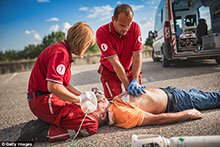IELTS Listening Practice Performing CPR IELTS Listening Practice Performing CPR About this activity This activity is labeled round table by Dr. Hariri, the creator and administrator of LELB Society. This activity is on the premise of Flipped Learning, according to which the students watch a video before the class, carry out research into the selected theme, and prepare themselves for an informed discussion in the class. This activity is on the basis of both synchronous and asynchronous computer-mediated communication (CMC), according to which the students are also encouraged to be active even before the class. In this flipped classroom activity, the students are encouraged to utilize the comment form at the bottom of the post to to exchange their questions, findings, and experiences with each ...
Home » Listening Practice in English » IELTS Listening Practice Performing CPR

IELTS Listening Practice Performing CPR
Updated: by Dr. Mohammad Hossein Hariri Asl
Time to Read: 5 minutes | 311 Views | 9 Comments on IELTS Listening Practice Performing CPR
Share This Post
About the Author
Dr. Mohammad Hossein Hariri Asl is an English and Persian instructor, educator, researcher, inventor, published author, blogger, SEO expert, website developer, entrepreneur, and the creator of LELB Society. He's got a PhD in TEFL (Teaching English as a Foreign Language).
Number of Posts: 4224



5. What is the difference between normal breathing and agonal breathing?
4. How to locate a carotid pulse on an adult or child?
Corrections:
This question form only appears in titles.
3. What does AED stand for?
In the context of CPR (cardiopulmonary resuscitation), AED stands for “Automated External Defibrillator.” An AED is a portable electronic device that automatically diagnoses life-threatening cardiac arrhythmias and can deliver an electric shock to help the heart re-establish an effective rhythm. AEDs are designed to be used by laypeople, with simple audio and visual instructions to guide the user through the process of providing a potentially lifesaving intervention.
2. How many breaths and compression should be performed in a CPR cycle?
In a CPR cycle, the recommended ratio for adults is 30 chest compressions followed by 2 rescue breaths. This cycle is repeated until professional medical help arrives or the person starts showing signs of recovery. The chest compressions should be delivered at a rate of 100 to 120 compressions per minute, with a depth of about 2 inches (5 cm) for adults. For infants and children, the ratio and depth of compressions can vary slightly, so it’s important to be trained specifically for different age groups.
1. What is the first action that you need to take when you see someone is lying down on the floor?
Corrections:
The structure of sensory verbs:
you see someone is lying down ➡ you see someone lying down